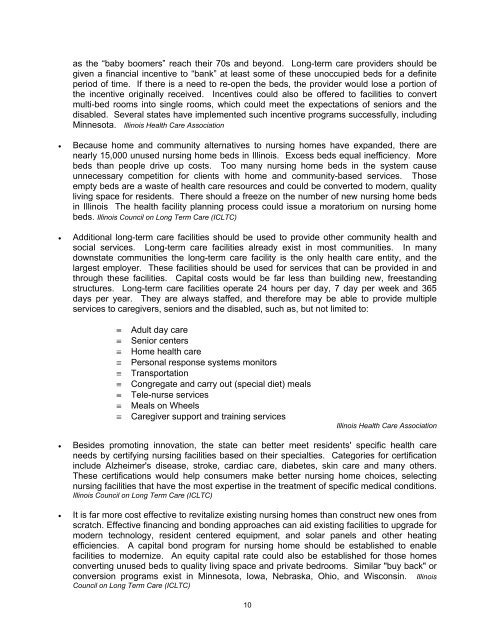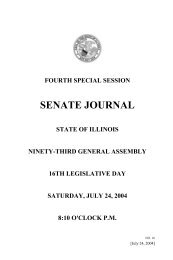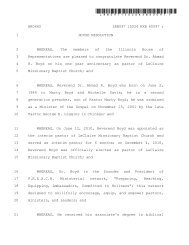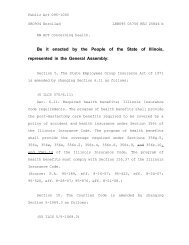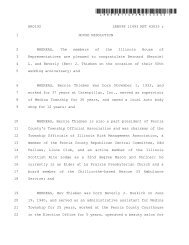Long-Term Care - Illinois General Assembly
Long-Term Care - Illinois General Assembly
Long-Term Care - Illinois General Assembly
You also want an ePaper? Increase the reach of your titles
YUMPU automatically turns print PDFs into web optimized ePapers that Google loves.
as the “baby boomers” reach their 70s and beyond. <strong>Long</strong>-term care providers should be<br />
given a financial incentive to “bank” at least some of these unoccupied beds for a definite<br />
period of time. If there is a need to re-open the beds, the provider would lose a portion of<br />
the incentive originally received. Incentives could also be offered to facilities to convert<br />
multi-bed rooms into single rooms, which could meet the expectations of seniors and the<br />
disabled. Several states have implemented such incentive programs successfully, including<br />
Minnesota. <strong>Illinois</strong> Health <strong>Care</strong> Association<br />
• Because home and community alternatives to nursing homes have expanded, there are<br />
nearly 15,000 unused nursing home beds in <strong>Illinois</strong>. Excess beds equal inefficiency. More<br />
beds than people drive up costs. Too many nursing home beds in the system cause<br />
unnecessary competition for clients with home and community-based services. Those<br />
empty beds are a waste of health care resources and could be converted to modern, quality<br />
living space for residents. There should a freeze on the number of new nursing home beds<br />
in <strong>Illinois</strong> The health facility planning process could issue a moratorium on nursing home<br />
beds. <strong>Illinois</strong> Council on <strong>Long</strong> <strong>Term</strong> <strong>Care</strong> (ICLTC)<br />
• Additional long-term care facilities should be used to provide other community health and<br />
social services. <strong>Long</strong>-term care facilities already exist in most communities. In many<br />
downstate communities the long-term care facility is the only health care entity, and the<br />
largest employer. These facilities should be used for services that can be provided in and<br />
through these facilities. Capital costs would be far less than building new, freestanding<br />
structures. <strong>Long</strong>-term care facilities operate 24 hours per day, 7 day per week and 365<br />
days per year. They are always staffed, and therefore may be able to provide multiple<br />
services to caregivers, seniors and the disabled, such as, but not limited to:<br />
≡<br />
≡<br />
≡<br />
≡<br />
≡<br />
≡<br />
≡<br />
≡<br />
≡<br />
Adult day care<br />
Senior centers<br />
Home health care<br />
Personal response systems monitors<br />
Transportation<br />
Congregate and carry out (special diet) meals<br />
Tele-nurse services<br />
Meals on Wheels<br />
<strong>Care</strong>giver support and training services<br />
<strong>Illinois</strong> Health <strong>Care</strong> Association<br />
• Besides promoting innovation, the state can better meet residents' specific health care<br />
needs by certifying nursing facilities based on their specialties. Categories for certification<br />
include Alzheimer's disease, stroke, cardiac care, diabetes, skin care and many others.<br />
These certifications would help consumers make better nursing home choices, selecting<br />
nursing facilities that have the most expertise in the treatment of specific medical conditions.<br />
<strong>Illinois</strong> Council on <strong>Long</strong> <strong>Term</strong> <strong>Care</strong> (ICLTC)<br />
• It is far more cost effective to revitalize existing nursing homes than construct new ones from<br />
scratch. Effective financing and bonding approaches can aid existing facilities to upgrade for<br />
modern technology, resident centered equipment, and solar panels and other heating<br />
efficiencies. A capital bond program for nursing home should be established to enable<br />
facilities to modernize. An equity capital rate could also be established for those homes<br />
converting unused beds to quality living space and private bedrooms. Similar "buy back" or<br />
conversion programs exist in Minnesota, Iowa, Nebraska, Ohio, and Wisconsin. <strong>Illinois</strong><br />
Council on <strong>Long</strong> <strong>Term</strong> <strong>Care</strong> (ICLTC)<br />
10


